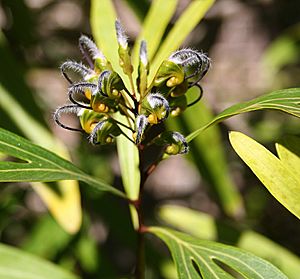Byfield spider flower facts for kids
Quick facts for kids Byfield spider flower |
|
|---|---|
 |
|
| Young inflorescence | |
| Conservation status | |
| Scientific classification | |
| Genus: |
Grevillea
|
| Species: |
venusta
|
The Grevillea venusta, often called the Byfield spider flower, is a special kind of woody shrub. It's part of the Proteaceae plant family. You can find it growing naturally in a small area of central Queensland, in eastern Australia. This plant is known for its bright green leaves. It also has very unusual flowers that are green, gold, and almost black!
Contents
Discovering the Byfield Spider Flower
Have you ever wondered how plants get their names? This is called taxonomy. The Byfield spider flower was first described by a botanist named Robert Brown. He found a sample of this plant near Cape Townsend in Queensland in August 1802. Later, in 1811, he officially named it.
The second part of its name, venusta, comes from a Latin word. Venustus means "charming," "lovely," or "graceful." It's a perfect name for such a beautiful plant!
What Does the Byfield Spider Flower Look Like?
The Byfield spider flower is a spreading shrub. It can grow quite large, reaching up to 5 meters (about 15 feet) tall and wide. Its branches are brownish and have tiny hairs.
The leaves are bright green and can be up to 19 centimeters (about 7.5 inches) long. Some leaves are simple and narrow, about 1 to 2 centimeters wide. Others might be split into two or more parts.
This plant blooms from autumn all the way through spring. Its flowers are very unique! They grow in cylindrical shapes, called inflorescences, at the ends of the branches. Each flower cluster is about 5 to 9 centimeters (2 to 3.5 inches) long.
Each cluster has 12 to 20 individual flowers. The base of each flower is green. Then, it turns gold, and the very top parts, called styles, are purple-black. These styles are covered with short white hairs, making them look even more interesting. After the flowers, greenish seedpods grow. They are about 1.6 to 1.9 centimeters long.
Where Does the Byfield Spider Flower Live?
The Byfield spider flower only grows in a specific part of Central Queensland. You can find it around Byfield National Park and Shoalwater Bay. Because it grows in such a small area, the Australian government has listed it as vulnerable. This means it needs protection to make sure it doesn't disappear.
It likes to grow in sandy soils. You can often spot it on ridges or in dry eucalypt forests.
Growing the Byfield Spider Flower
People have been growing the Byfield spider flower in gardens since the early 1970s. It's a great plant for smaller gardens. It grows easily if you plant it in a sunny spot. It also needs soil that drains water well.
This plant is quite tough! It can handle cold weather (frost) and humid conditions. The Byfield spider flower is also special because it's a parent to two other popular garden plants.
- One is called Grevillea 'Orange Marmalade'. It was created by crossing the Byfield spider flower with another plant called Grevillea glossadenia.
- The other is Grevillea 'Firesprite'. This one was made by crossing the Byfield spider flower with Grevillea longistyla.


